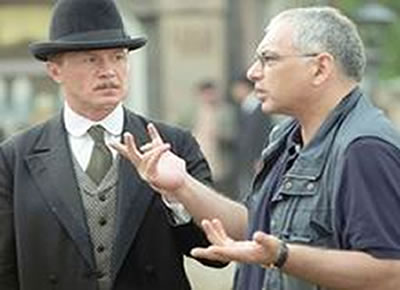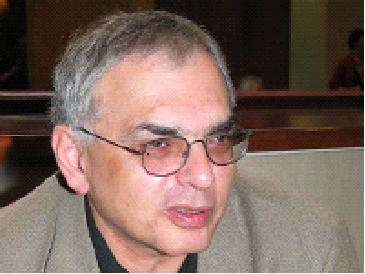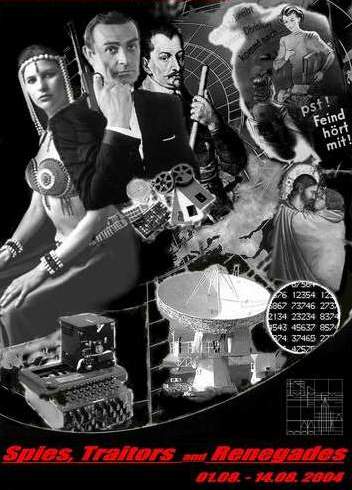Karen Shakhnazarov’s Brand of Terror
“The world offers itself to us in full spectacle, but there is nothing to see except a deluded man who calls himself Emperor standing naked in the street”,(<www.guidetopsychology.com/terrorism.htm>) “King of terror hits Moscow cinema screens,”(<www.newsfromrussia.com>) “A Rider Named Death: Terrorism Before Chechnya,”(An interview Dostoyevsky vs.Nietzsche by Olga Shumyatskaya at www.english.mn.ru, N 39, 2004.) “In his new film, Karen Shakhnazarov uses Russian history to revisit the issue of terrorism…”(<www.filmfestival.com>)
These are only some of the titles which followed the international premiere of Karen Shakhnazarov’s latest film Vsadnik po imeni smert (The Horseman Named Death) , one of the most high-profile Russian film projects of recent years.
The screen version of the novel Kon bledny (The Pale Horse) by R. Ropshin (pen-name of Boris Savinkov, Russian terrorist at the turn of 19th and 20th century) tackled a problem of today’s “deadliest plague.”(The term that Ben Barker uses in article International Terrorism: The Deadliest Plague on www.fee.org.) Although usually the media nowadays tend to judge terrorists in terms of the effects of their acts on a social and political reality, Karen Shakhnazarov has chosen to put in front of a public-eyel the “inner deeper region” motives (i.e. those that come from a mental/emotional sphere of a certain person) and the effects on a person after terrorist behavior.
The movie transfers the viewers to Moscow in the early 20th century. Historical resources indicate that the fighting organization (Voevaja organizacija) committed a series of crimes aimed against highly-positioned political figures. Final statistics show that 600 terrorist acts caused the deaths of 17,000 people.
Boris Savinkov (1879-1925) was one of the “Esery” and leader of the Socialist-Revolutionary Party. He was involved in a number of counter-revolutionary plots against the Bolsheviks, sometimes collaborating with the British Secret Intelligence Service (SIS).(See: http://boris-savinkov.wikiverse.org/)
The plot of the movie is quite linear and simplified: George (i.e. Boris Savinkov), with the members of revolutionary organization, plans and performs the assassination of the Grand Duke at the Moscow Opera in 1904. Although the film addresses the subject of terrorism, Shakhnazarov stressed in different interviews that he is interested not in statistics, but in the people “convinced that they have the right to bomb and kill other people.”(Dostoyevsky vs.Nietszsche by Olga Shumyatskaya at www.english.mn.ru, N 39, 2004.)
The mental image of a person who commits terrorist acts, not the consequences of an act (or an act by itself), is the central issue on which director of Russian Mosfilm aims to offer a possible response. Therefore, The Horseman Named Death could be seen as a study in the psychology and sociology of terror, rather than in its political and economical side.
Who is a terrorist? How responsible is a role of a governmental order in creating an image of terrorists? Why does one choose, among all various life-roles, that which speaks with a language of weapons and violence? And how justified – although art should, in order to maintain independence, avoid political and ideological correlation – is an approach(Karen Shakhnazarov emphasized that “an artist is like a doctor and should not be concerned with people’s political biases.” Dostoyevsky vs. Nietzsche, by Olga Shumyatskaya, The Moscow News, www.english.mn.ru, N 39, 2004.) which reveals a terrorist in a “human” light (and considering that the character is an extremely remarkable, symptomatic, and influential social phenomenon)?
WHO’S TO BLAME?
Some studies about the question of terrorism emphasize governmental influence in creating terrorism. From that point of view, governmental / political power distribution is seen as a system that works by lines of ideology in the same extent as terrorists do. That approach puts politicians and terrorists on “different sides of the same coin.” “Confrontation between terrorist groups and governments” is explained as “an outgrowth of adeeper ideological struggle.”
In Shakhnazarov’s film, “a serious attempt to analyze the emergence of terrorism,”(An interview with Mihkail Shvydkoi, the head of the Federal Culture and Cinema Agency, at www.newsfromrussia.com.) the social revolutionary George (Boris Savinkov) was “extremely credible, true-to-life hero,” “torn under by conflict within” He is “a rare breed,” a “terrorist who was able to tell his story with literary skills,” a “prominent theoretician of terrorism,” “a suffering person,” “not a killing machine,” and who “overcame a great spiritual crisis.” Ideological determination is “in shadow.” He suggests that, indeed, ideological confrontation is a starting motivation point, but the true struggle happens with “under-cover” ideology: in a person’s mental or psychological sphere. George becomes a moral wreck; the process causes struggles that destroy him – that is the side on which Shakhnazarov had focused his intention.
Traditional analyses of terrorism point out low self-esteem, irrationality, and insanity as the characteristics that determine and give birth to terrorist behavior. The image of George, presented in the Shakhnazarov’s film, mostly does not fit into these categories. He is, even when “shaken inside” with unsuccessful outcomes, highly certain of the justifiability of his acts.
At the same time, the viewer gets the impression he considered his actions rationally and is definitely not insane. George is presented as quite a cold person – the expression of his face does not change even when it is obvious that he is going through a difficult emotional and intellectual struggle.
He is, indeed, indifferent to the fact that the people who he had chosen as his targets are also human beings, and is apathetic to everybody who does not serve his own violent interests. The fact that he gives himself to a relationship with another man’s wife proves that he doesn’t suffer from social (or economical) alienation.
He does represent a figure of a political renegade, as was the role that was once played by all members of Russian society who did not agree with the system. If we consider terrorism as the “natural and inevitable consequence of ideologies supported by existing governments” and a “violent mode of persuasion,”(International terrorism: The Deadliest Plague, Ben Barker, www.fee.org.) political treachery could therefore be responsible for the turn to violence.
After having lost power in achieving justice through legitimate acts, George reaches out to more forceful methods. By doing so, he, as an individual that feels powerful, gives himself the right to take another person’s destiny into his hands; he “gain[s] the kind of significance that most likely could not be gained by legitimate channels.”(Terrorism, Bill Anderson, www.libertyhaven.com.)
A short overview of Russia at the turn from the 19th to 20th century shows that the power was in the hands of a wealthy minority which ruled the life (in the way that was appropriate for and served their own interests!) of the poorer majority. George’s acts therefore could be depicted even as a form of altruistic behavior, which is a new light that Shakhnazarov (wanting to or not) threw on the nature of terror.
George’s lawlessness,(To the question “Who gave you the right to kill others?” George answers morosely: “I’ve created my law.”) as presented in The Horseman Named Death, was spawned by governments which had abandoned the rule of right in favor of the rule of force. The violent methods of those who are standing higher on the political hierarchy, in that case, highlight the violence of the “suffering,” disinherited majority.
What happens in systems in which the rule of a law is replaced by the rule of force, i.e. those that deny “an external primary source of morality,” is that: 1) “morality springs from subjective sources,” and 2) the rule of force leads to lawlessness. “Implementation of justice then is based upon common acceptance of objective principles of behavior-or upon morality.”
Exposing the nature of George’s terrorist activity (i.e. terrorism in general) through the pattern of behavior in which it was legitimate to create personal moral laws, nevertheless does not change the fact that, by using coercion to extract his private ideas to others, he behaved in the same manner as those against whom he is fighting.
IMMORALITY – CLEARED FROM CHARGE?
If the question of morality is a central focus of Shakhnazarov’s film, the critic could be directed to the simplified approach to a question that is not one-sided and homogeneous. The question of morality therefore should have been analyzed in more circumspective categories. The fact is that “self-called” altruistic behavior, no matter to what extent one can justify oneself by the unfairness of the government, is just covering self-orientated and personal desire for power and influence. That is, terror is “an act of individual self-determination,” and thus creates the illusion of gaining the ultimate power against the state.
On the other side, by focusing the viewer’s intention to an “inside look” into the personality of George at the point when it seems he lost track of the final goal, Shakhnazarov aims to show that “in the long run,” a terrorist comes to a complete moral collapse.
“By taking the path in murder, a person degrades even if he is driven by a noble idea.” There are two major suggestions created in The Horseman Named Death. Firstly, that every human being (as is the terrorist, too) is a result of the forces acting upon him, and secondly that terror itself becomes more important then the purpose for which it is perpetrated.
As far as it is certain that aggression and violence itself (not “higher truth” motives) eventually begin to reign the terrorist, the terrorist is not an evil, “angry man acting on his own destructive impulses – he is merely another victim of society.” Therefore one can “read between the lines” of Shakhnazarov’s movie that, basically, George is not responsible for his own lawlessness – it is his heritage (family, society in general, political determination) that is responsible.
His behavior then is just (an unavoidable?) consequence of his present social interactions, history, and future that is, as a possibility, present in a moment of action. Although this may be true to some extent, major critics can ask what is (on purpose?) “left out” from that apparently innocent concept.
The fundamentally important point is that the world is full of “bitter hearts,” but the problem is that these people find terrorism as a way to express their dissatisfaction (which seems to be George’s case); they gain power and eliminate their internal bitterness in ways that are very harmful towards other individuals and society in general.
The moral collapse that appears in the moment when George realizes that by committing himself to terrorist acts he won’t achieve what he expected (which causes his moral fracture), shows not his humanity, but rather his inability to understand how the system works. One could read that he passionately worked against the system, while at the same time not understanding how it operates. The problem is far deeper: extermination of one political figure will only result in his replacement by another one. And the final goal won’t be reached.
FILM CHARACTER AS SIGNIFICATION / NARRATIVE REPRESENTATION
While the previous interpretation approached the character of Shakhnazarov’s film rather from a sociological point of view, another approach should be mentioned. Namely, “hand in hand” with a sociological determination of all constructive elements of film (mostly because film is, maybe more direct then other forms of art, the media that articulates and reflects political, cultural and day-to-day human praxis), the semiotic point of view implies that, like all cultural products, film characters are, when realized in media texts, significations.
This approach to the phenomenon of spies, traitors, renegades and terrorists was examined by young scientists and students at the Constance International Summer School(All quotations in this chapter, along with more information about the mentioned theory of literature summer school can be found at www.uni-konstanz.de/kis.), which was held at University in Konstanz during August of last year.
By focusing the attention on the interpretation how the figures named above are reflected in literature and film (that was depicted also as a narrative genre), the participants of Konstanz theory of literature summer school started with the presumption of Russian structuralist Yuri M. Lotman, who “emphasized that the transgression and breaking down of the borders of semantic spaces is constitutive for the development of every literary subject.”
In this context, the figures of “political orders’ renegades” present a perfect model of a character, and their textual transformation in linguistic signs, that articulates meaning and sense in “ambiguity and uncertainty, from the interplay between truth and lies, reality and fiction, dissimulation and discovery.”
While American / English studies explored “how agents of commerce, colonial enterprise, and imperial politics constitute exemplary heroes and heroines of English fiction,” German studies focused on “texts and films that deal with the secret side of power,” film / media studies on “a number of American and European films in which secret agency is eminent,” and Slavic studies offered a scale of different types of agents that were articulated in Russian and Czech literature since its beginning and Soviet film in Stalin and post-Stalin periods.
The figure of Boris Savinkov / George, as materialized in Shakhnazarov’s film, incorporates image particularities that interested students and professors at the aforementioned summer school. In this context, the mental collapse of Boris Savinkov is written in a dialectical nature of all characters of his kind: as all spy, traitor or renegade figures, he lived in a “space between.”
He is always divided between multiplied identities: as an individual he wants to stay free and independent, but he is strongly defined with his activity in the terrorist organization; he vacillates between living and acting, private and public, truth and lie. Dialectic and dynamic “space between” was a reality that which he resigned himself when decided to become a terrorist. A dual entity designated his mental agony and consequence that followed it, which is the concept emphasized in Shakhnazarov’s film.
A VIEWER’S REVIEW
Historical perspective which undoubtedly gave Shakhnazarov the courage to face the terror problem in the simplified way presented in The Horseman Named Death could nevertheless influence his viewers, who read of deadly statistics and sequels of terror acts, in newspapers every day.
Nowadays, when the terrorism around the globe is, simply, too palpable and real to be explained and adjusted with rational categories, and when it’s quite clear it has an insane (religious) fanaticism in its roots, it is difficult to accept (except maybe with autonomy-of-an-art reasons) the view of terrorists that Shakhnazarov suggests in The Horseman Named Death.
George’s mental turmoil could, indeed, be taken with understanding; it can be even attractive, if one could forget the reasons which made him drown in his own violent ideas. His allegation “I want it, therefore I do it!” caused the death of many people, which is a fact that Shakhnazarov seems to forget.
Therefore, one could agree with Russian reviewers who were quite explicit in taking neutral (some more negative then positive) standpoints. While Tarhanova emphasizes that “Shakhnazarov gives a recipe how to make from any kind of terrorism a comedy: one should use a journal of a terrorist and throw out all the reasons which made him start writing in the first place.”(K. Tarhanova at www.film.ru.) Ekaterina Barabash finds in the sub-text of a movie a fact that it proves that the terrorism had its roots in a far past.(Ekaterina Barabash in Nezavisimaya gazeta, www.film.ru.) The same critic points out that history repeats itself not only as a mockery, but also in a tragedy of three or four times the force.(Ibid.)
Therefore, in the background of Boris Savinkov’s story, one could find a symbolical meaning in an accidental congruity: The Horseman Named Death had its premiere on the 3rd of September, the same day when the Beslan tragedy took place. When commenting on his film, Shakhnazarov indicated that one can read Chechnya into the movie “only to the extent that it makes us reflect on the psychology of terrorists.”(A Rider Named Death: Terrorism Before Chechnya, www.filmfestivals.com.)
At the same time, since the Beslan tragedy is observed in media as a “collapse of special services and central authorities,” the same message is sent by a Shakhnazarov’s film: the fact that George, a century ago, managed to carry a bomb into a public building undisturbed, in a beauty cream-package, proves that prevention methods against terrorism did not work in the past, just as they are not functioning today. The presence of terrorism is a reality today; its elimination will require more methodical, better planned actions.(According to articles at www.agentura.ru, a law against terrorists did not function until 11th June 2001.)
Although it is quite clear that terrorism does not appear out of nowhere, the disclaimer that every human being has a freedom to choose will not solve the problem; it will just throw the “responsibility-ball” to somebody or something else.
George / Boris Savinkov is and was (despite the potential of sympathy for his mental collapse and internal struggles) “a king of terror,” a “Russian bin Laden,” “a Raskolnikov of the 20th century,” a Russian “Sidney Riley” and, after all, “The Horseman Named Death.” He is one of the leading terrorists of the 20th century.







